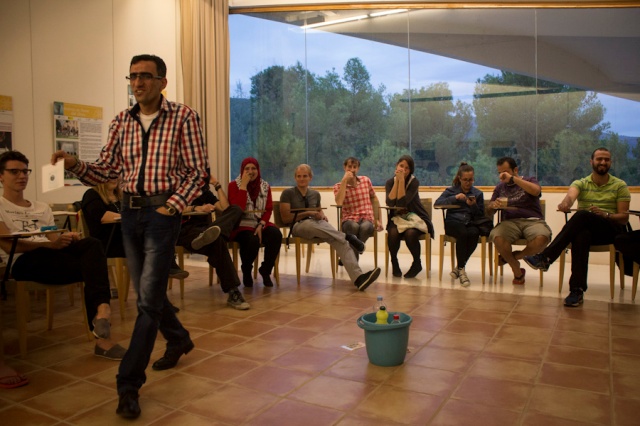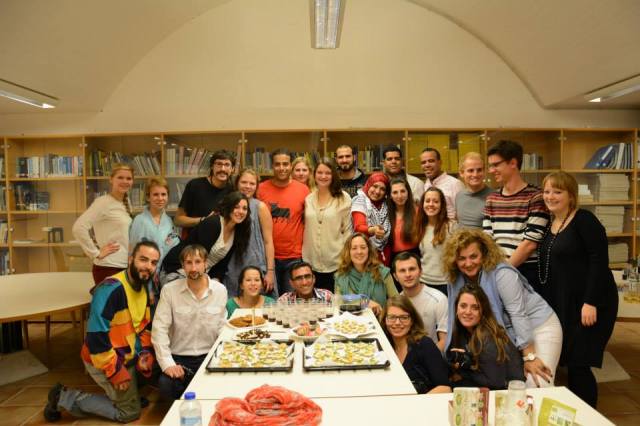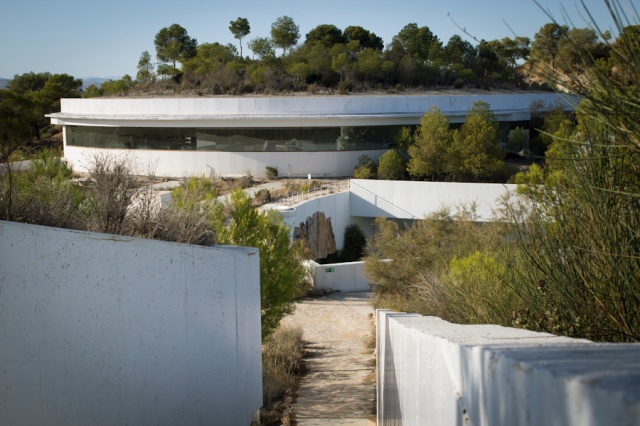Day 1 – Monday: Hello, Γεια, Hi, Hej, Hola, Cześć, مرحبا
We had been talking for weeks about this day. The day when the training course will start and we will meet all the other participants. Finally came the day.
We arrived at CEMA CAM Torre Guil, a bioclimatic centre used for environmental education such as training courses, workshops, conferences etc. Very innovative back when it was built. The first day was a good blend of practical information, introduction and games to get to know each others names and interests. Egypt, Greece, Italy, Jordan, Latvia, Marocco, Slovenia, Sweden, Spain, Palestine, Poland and Romania name the home countries of the 25 amazing participants. Plus our marvelous organizers Mairita and Carmen, that succeeded taming, entertaining and educating us.
Day 2 – Tuesday: Save energy!
One of our first workshops was organized by the Spanish NGO Columbares. One of their activities is the program “Hogares Verdes”, Green Homes, in which they work with families and households in Spain to raise environmental awareness and educate them about how to save energy and water, that is how to live a greener life. An exercise followed for us, divided into geographically close countries, about how we could get families involved in similar projects in our countries. In the photo Sweden and our Nordic friends from Latvia are working hard on designing a 3-phase program for single-households and families. We also discussed environmental topics such as the reduction of single-used products like the beloved coffee-to-go or daily take-away lunch box. Maybe one can introduce real ceramic cups and install return stations scattered over the town? To defeat the overflow of single-households, one could establish a community life-project in which alone-living and cooking people can combine their basic activities, such as grocery shopping, cooking, car-using etc. Also it was super interesting to hear different ideas from the other countries. The day continued with lunch, power siesta and a crisis simulation and which we had to labour all our synapses to find the best way organizing a town without electricity but hungry inhabitants. We came up with different ideas and strategies but also came to the conclusion, that energy is not always present or abundant, so that one should consume it consciously. On the one hand, there are actions you can do. Like turning off the light when you leave the room, but also there are some innovative devices. Have you heard about energy meter to monitor your actual consumption, timers to limit the charging time of your cellphone during the night, or even better, a solar-driven mobile phone charger?
Day 3 – Wednesday: Saving water and responsible consumerism
Craving a banana? Go and buy one in the next supermarket, you get it for just 20 cents! Where does it come from, Costa Rica maybe? Imagine you’re working there on a banana plantation under harsh and unhealthy conditions – I’m sure you would want a big part of the 20 cents to compensate your hard job. In an energetic and passionate role play of the whole supply chain we debated, fought, compromised with the workers, the plantation owners, the importers, the shippers and the supermarkets; and in the end all had to lower their portion of the banana to meet the consumers demand on a price as low as possible. It might be good to remind oneself that fewer middlemen often result in more percent of the price to the farmer. The poor worker gets only 4 % of the profit per banana! Thinking of this, buying a banana is not as easy anymore.
Responsible consumerism is the complex topic and it doesn’t end with the banana. More exotic fruits, vegetables, cotton and products as for example clothes have the same background story. We continue checking the labels of over our clothes to create a map where they have been made. Contrasting these blue dots with red dots for countries where we have lived, clear trends show up. China and Southeast Asia is becoming more and more popular for tourism but it still is more reigned by clothes productions. The Ethical Consumer is a good web page to find out about the impact or all kinds of products and values of different companies.
The afternoon was full of water. Using water, saving water, hidden water. We talked about different actions and devices to save water and tested ourselves by guessing the amount of hidden water, that is all water needed for one product like coffee, meat or paper from the beginning to the end of the production chain. You’ll be surprised how big your water footprint actually is! For example you need 140 liter to produce one cup of coffee.
 Workshop about how to save water
Workshop about how to save water
Day 4 – Thursday: A day of Murcian history and Spanish food
On Thursday we had a break from the workshops. It was time for some sightseeing in the city of Murcia. We had local guide who guided us around the city. Murcia is an old, very beautiful city with a lot of interesting history. If you visit south of Spain, we can definitely recommend this city.
 After a free afternoon the group met up at a typical Spanish restaurant. We had lovely tapas for dinner. The evening ended at a pub with a local live-band. Something that was a bit of a signature for our group was that as soon that we heard some music it was time for some dancing, here somewhere in the middle of the old town with an amazing street musician 🙂
After a free afternoon the group met up at a typical Spanish restaurant. We had lovely tapas for dinner. The evening ended at a pub with a local live-band. Something that was a bit of a signature for our group was that as soon that we heard some music it was time for some dancing, here somewhere in the middle of the old town with an amazing street musician 🙂
Day 5 – Friday: Presentation of CEMA Torre Guil, entrepreneurs presentation
After breakfast we had a guided tour around the centre CEMA with our fantastic organizer Carmen. CEMA is a unique centre in the way it is constructed and how it uses the environment where it is located. Solar panels are a very important source for electricity and to heat up the hot water for the showers. Most of the rooms have big windows so the daylight can reach even the corner in the room. A thing of the centre that interested me was the thoughts of impact on the environment when the centre was build. When the CEMA was build the architects did not want to make a big impact on the surroundings. It is built in different levels, and trees and bushes were planted back on roof, which also works as an isolation.
In the afternoon we had local entrepreneurs visited us that presented their business ideas connected to sustainability. It was a great mixture of topics: two women had started an ecological agriculture business, for families in the neighbourhood to order a basket of these locally grown vegetables and fruits. Another project takes place in Murcia city promoting the use of bicycles in the city – put the fun between your legs! A sustainable way of transportation that not only makes fun but is also healthy and makes you more happy! A third entrepreneur presented his company that produce for example furniture, toys for kids, marketing material, and whole exhibitions – all out of recycled cardboard solely. This afternoon was one of the most interesting afternoons for us, getting inspired by people that believe in a business idea and make their dream come true.
Day 6 – Saturday: Natural Park, Future planning, Last dinner
After an excursion to the beautiful natural park San Pedro del Pinatar where we saw flamingos, salt lakes and learnt about the special plants that live in these extreme conditions we went back to the centre to create some ideas about possible future projects.
Day 7 – Sunday: See you
We have to say, this whole week was simply fantastic. Not only we learned a lot about how to live a greener life and had plenty of stimulating discussions, but also we learned to communicate these important but sometimes heavy topics in a playful and effective way. Thank you, Mairita and Carmen for this whole experience! We made new friends. Amazing people from all different countries. Thank you all for a week full of fun, laughing, dancing and exchange of ideas and languages! We hope to meet you all again in the future, may it be for a common project, a banana game or just for a green reunion 🙂
We got inspired by all we’ve learnt and discussed in the course, and now want to give this experience to our future green fellows. Go green! Save the planet! Stay updated and see you at our event!
Thanks to Claudia Alonso for the beautiful photos!
Lara Schultes, Sofia Söderberg – participants from Global Playground Stockholm














